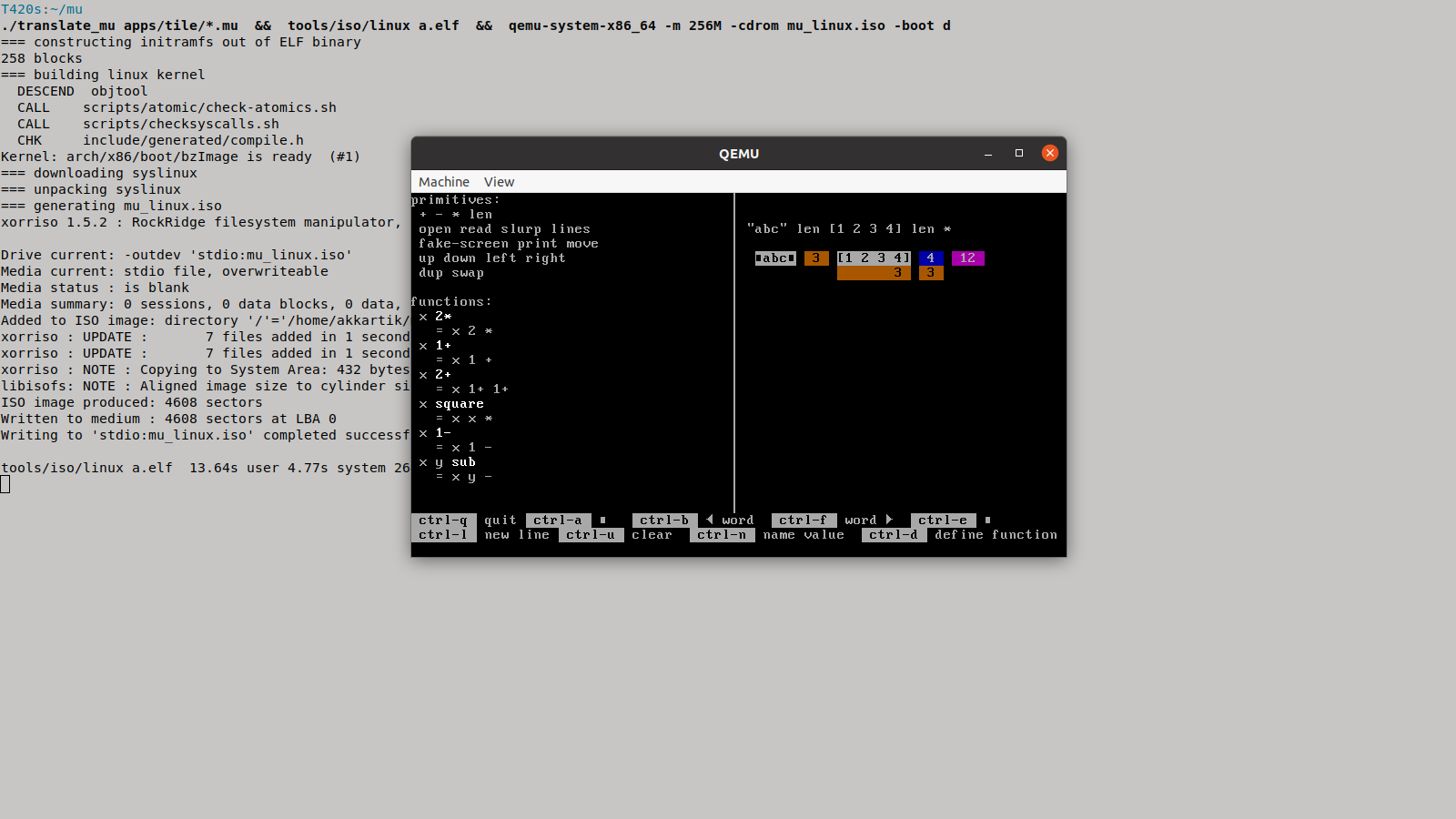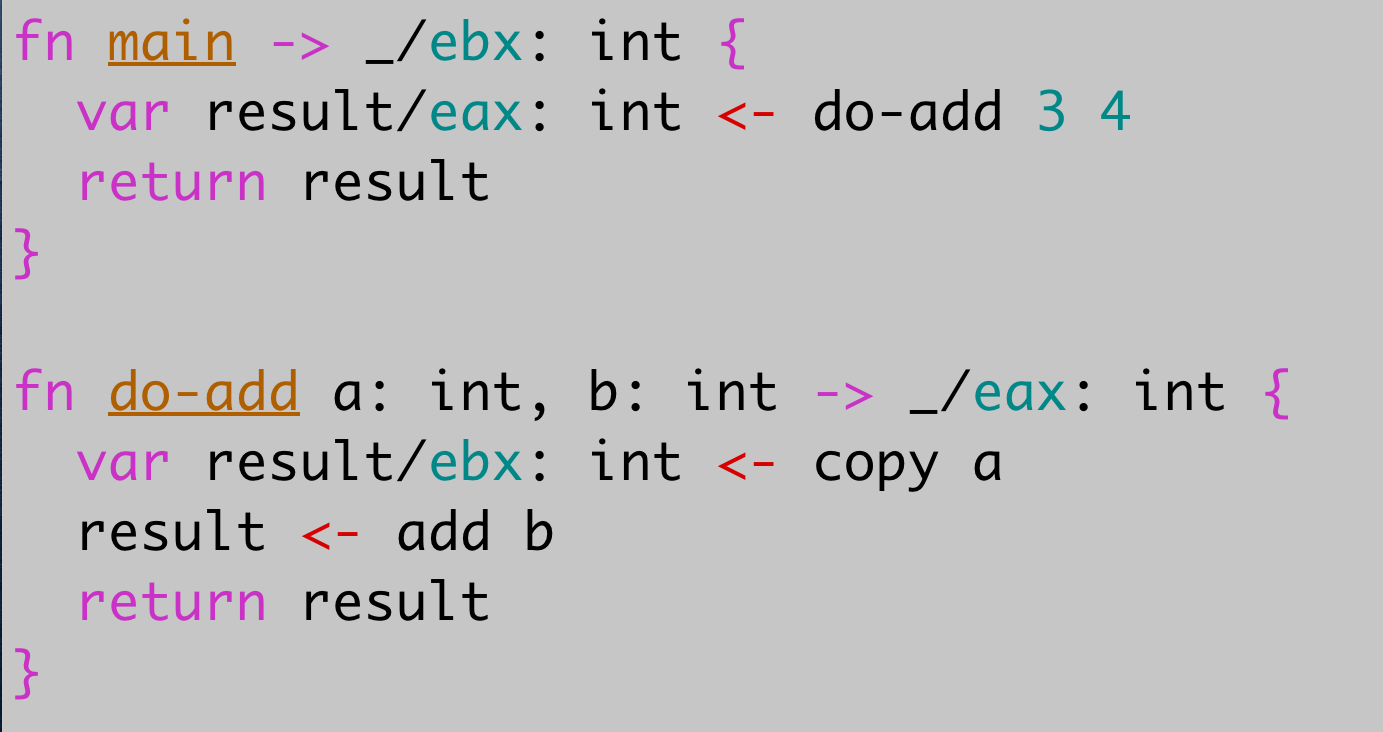11 KiB
Mu: a human-scale computer
Mu is a minimal-dependency hobbyist computing stack (everything above the processor and OS kernel).
Mu is not designed to operate in large clusters providing services for millions of people. Mu is designed for you, to run one computer. (Or a few.) Running the code you want to run, and nothing else.
$ git clone https://github.com/akkartik/mu
$ cd mu
$ ./translate_mu apps/ex2.mu # emit a.elf
$ ./a.elf # add 3 and 4
$ echo $?
7
Rather than start from some syntax and introduce layers of translation to implement it, Mu starts from the processor's instruction set and tries to get to some safe and clear syntax with as few layers of translation as possible. The emphasis is on internal consistency at any point in time rather than compatibility with the past. (More details.)
Currently Mu requires a 32-bit x86 processor. Generated programs require just a Linux kernel and nothing else.
Goals
In priority order:
- Reward curiosity.
- Easy to build, easy to run. Minimal dependencies, so that installation is always painless.
- All design decisions comprehensible to a single individual. (On demand.)
- All design decisions comprehensible without needing to talk to anyone. (I always love talking to you, but I try hard to make myself redundant.)
- A globally comprehensible codebase rather than locally clean code.
- Clear error messages over expressive syntax.
- Safe.
- Thorough test coverage. If you break something you should immediately see an error message. If you can manually test for something you should be able to write an automated test for it.
- Memory leaks over memory corruption.
- Teach the computer bottom-up.
Non-goals
- Speed. Staying close to machine code should naturally keep Mu fast enough.
- Efficiency. Controlling the number of abstractions should naturally keep Mu using far less than the gigabytes of memory modern computers have.
- Portability. Mu will run on any computer as long as it's x86. I will enthusiastically contribute to support for other processors -- in separate forks. Readers shouldn't have to think about processors they don't have.
- Compatibility. The goal is to get off mainstream stacks, not to perpetuate them. Sometimes the right long-term solution is to bump the major version number.
- Syntax. Mu code is meant to be comprehended by running, not just reading. For now it's a thin veneer over machine code. I'm working on memory safety before expressive syntax.
Toolchain
The Mu stack consists of:
- the Mu type-safe language;
- SubX, an unsafe notation for a subset of x86 machine code; and
- bare SubX, a more rudimentary form of SubX without certain syntax sugar.
All Mu programs get translated through these layers into tiny zero-dependency ELF binaries that run natively on Linux. The translators for most levels are built out of lower levels. The translator from Mu to SubX is written in SubX, and the translator from SubX to bare SubX is built in bare SubX.
There's an emulator for running Mu binaries (more slowly) on other Unix-like systems.
$ ./translate_mu_emulated apps/ex2.mu # emit a.elf using the emulator
$ ./bootstrap run ./a.elf # run in the emulator
$ echo $?
The emulator is also useful for debugging.
incomplete tools
There's a prototype Mu shell, a postfix language with a dynamically updating environment. It might turn into the initial experience when a Mu computer boots.
Once generated, ELF binaries can be packaged up with a Linux kernel into a bootable disk image. Here's how the Mu shell might look on startup:
$ ./translate_mu apps/tile/*.mu # emit a.elf
# dependencies
$ sudo apt install build-essential flex bison wget libelf-dev libssl-dev xorriso
$ tools/iso/linux a.elf
$ qemu-system-x86_64 -m 256M -cdrom mu_linux.iso -boot d

The disk image also runs on any cloud server that supports custom images.
Mu also runs on the minimal hobbyist OS Soso. (Requires graphics and sudo access. Currently doesn't work on a cloud server.)
$ ./translate_mu apps/ex2.mu # emit a.elf
# dependencies
$ sudo apt install build-essential util-linux nasm xorriso # maybe also dosfstools and mtools
$ tools/iso/soso a.elf # requires sudo
$ qemu-system-i386 -cdrom mu_soso.iso
Finally, there's a whole mini-universe inside the baremetal/ sub-directory,
Mu programs that use no Linux services, and can control the screen and
keyboard directly without an OS. You can make things like this with them:

To reproduce it:
$ ./translate_mu_baremetal baremetal/ex2.mu # emit disk.img
$ qemu-system-i386 disk.img
Syntax
The entire stack shares certain properties and conventions. Programs consist
of functions and functions consist of statements, each performing a single
operation. Operands to statements are always variables or constants. You can't
perform a + b*c in a single statement; you have to break it up into two.
Variables can live in memory or in registers. Registers must be explicitly
specified. There are some shared lexical rules. Comments always start with
'#'. Numbers are always written in hex. Many terms can have context-dependent
metadata attached after '/'.
Here's an example program in Mu:

Here's an example program in SubX:
== code
Entry:
# ebx = 1
bb/copy-to-ebx 1/imm32
# increment ebx
43/increment-ebx
# exit(ebx)
e8/call syscall_exit/disp32
Forks
Forks of Mu are encouraged. If you don't like something about this repo, feel free to make a fork. If you show it to me, I'll link to it here. I might even pull your changes into this repo!
- mu-normie: with a more standard build system that organizes the repo by header files and compilation units. Stays in sync with this repo.
- mu-x86_64: experimental fork for 64-bit x86 in collaboration with Max Bernstein. It's brought up a few concrete open problems that I don't have good solutions for yet.
- uCISC: a 16-bit processor being designed from scratch by Robert Butler and programmed with a SubX-like syntax.
- subv: experimental SubX-like syntax by s-ol bekic for the RISC-V instruction set.
Desiderata
If you're still reading, here are some more things to check out:
-
The references on Mu and SubX syntax, and also bare SubX without any syntax sugar.
-
How to get your text editor set up for Mu and SubX programs.
-
Shared vocabulary of data types and functions shared by Mu programs. Mu programs can transparently call low-level functions written in SubX.
-
A summary of how the Mu compiler translates instructions to SubX. (colorized version)
-
Some starter exercises for learning SubX (labelled
hello). Feel free to ping me with any questions. -
The list of x86 opcodes supported in SubX:
./bootstrap help opcodes. -
Some details on the unconventional organization of this project.
Credits
Mu builds on many ideas that have come before, especially:
- Peter Naur for articulating the paramount problem of programming: communicating a codebase to others;
- Christopher Alexander and Richard Gabriel for the intellectual tools for reasoning about the higher order design of a codebase;
- David Parnas and others for highlighting the value of separating concerns and stepwise refinement;
- The folklore of debugging by print and the trace facility in many Lisp systems;
- Automated tests for showing the value of developing programs inside an elaborate harness;
On a more tactical level, this project has made progress in a series of bursts as I discovered the following resources. In autobiographical order, with no claims of completeness:
- “Bootstrapping a compiler from nothing” by Edmund Grumley-Evans.
- StoneKnifeForth by Kragen Sitaker, including a tiny sketch of an ELF loader.
- “Creating tiny ELF executables” by Brian Raiter.
- Single-page cheatsheet for the x86 ISA by Daniel Plohmann (cached local copy)
- Minimal Linux Live for teaching how to create a bootable disk image using the syslinux bootloader.
- “Writing a bootloader from scratch” by Nick Blundell.
- Wikipedia on BIOS interfaces: Int 10h, Int 13h.
- Some tips on programming bootloaders by Michael Petch.
- xv6, the port of Unix Version 6 to x86 processors
- Some tips on handling keyboard interrupts by Alex Dzyoba and Michael Petch.